Bayena: Whales in Guam Waters
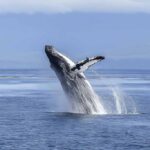
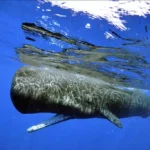
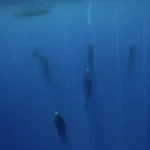
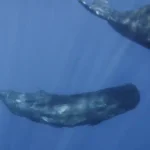

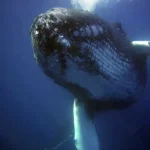
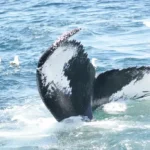
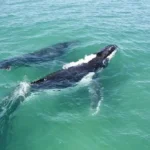
Table of Contents
Share This
Whales are mammals
Cetacea is an order of marine mammals that includes both whales and dolphins. They are clearly identified by their streamlined bodies and fins, which make them very fast and agile swimmers. Some species are able to reach speeds up to 35 mph. They are best known for their dramatic leaps or “breaching” out of the water.
Dolphin species, in particular, are loved for their ability to perform flips and tricks while in the water. They are similar to other marine mammals in that they have a thick layer of blubber that protects them from extreme cold temperatures in the water. They feed largely on fish or small marine invertebrates. However, some species, such as the well-known Orca, or killer whale, will also eat birds and small mammals.
Cetaceans are incredibly intelligent creatures with well-developed senses. Their vision and hearing are adapted for both above and below the water. Dolphins and smaller whale species are known to travel in tight-knit family groups. They are social creatures that use complex vocalizations to communicate, which has prompted a great deal of research into their group dynamics. Researchers in the Caribbean are working to identify and understand the “language” that some dolphin species use. The intelligence of cetaceans and their playful nature have driven media and popular culture to elevate this Order of animals to a celebrity status.
Here are some species from the order Cetacea that live in or pass through the waters surrounding Guam:
Sperm Whales (Physeter macrocephalus)
Classification and distribution
Sperm Whales make up the Physeteridae family, which once included Pygmy and Dwarf Sperm Whales, but now only describes the common Sperm Whale. They are the largest of the toothed whales. Females average 11 meters in length and weight 15 tons, while males average 16 meters and 45 tons.
The most prominent feature of Sperm Whales are their large, uniquely shaped heads. They take up one third of the Whale’s length and are block shaped. Inside of that large head is the largest brain of any animal, by weight, on earth, and a large pocket full of spermaceti, which is a thick mixture of liquid and fats. This is often shortened to “sperm,” and is the namesake for Sperm Whales. It is thought that this substance is crucial to the whale’s ability to make powerful clicking sounds that are used in echolocation and communication.
Sperm Whales are reportedly the most often spotted whale in surveys around Guam and the rest of the Marianas. Populations vary seasonally, but it is possible to see them at all times of the year. Sightings of these whales have been reported as early as the mid-1700s, which clearly establishes their existence in these tropical waters. In June 2013, a mature dead Sperm Whale washed up on the reef at Turtle Cove in Ylig Bay.
Life history
Sperm Whales make a vast number of different vocalizations that are believed to be important for both hunting and socialization. These clicks can be as loud as 230 decibels underwater, making it the loudest animal on the planet. Because of this volume, they are able to hear one another from thousands of miles away and communicate across oceans. The incredible power of their clicks is capable of vibrating a human body to the point of paralysis and even death.
Sperm Whales mostly eat squid, and they are known to dive to great depths in order to hunt for their prey. Dives can be as deep as 300 to 800 meters, with a maximum of 2 kilometers, and can last longer than one hour. Sperm Whales sleep in peculiar formations, where they group up and sleep in a vertical position just below the surface of the ocean.
Sperm Whales can live to be up to 70 years old. It is still unknown how they choose their mates, but males have been known to fight each other over females. Gestation takes 14 to 16 months for a single calf, and females are solely responsible for feeding and raising the babies. Males provide no paternal care to their offspring. A group of females will often live and raise offspring together in order to increase protections from predators such as Killer Whales.
There is some evidence that suggests Sperm Whales may raise their young near the Marianas Islands. Brent Tibbatts of the Department of Agriculture reports that the first ever documented newborn sperm whale found in the wild was found off the coast of Hågat with its umbilical cord still attached to its mother.
Local significance
Historically, Sperm Whales have been hunted for their valuable spermaceti, used to make candles, soaps, and various mechanical oils. They were believed to be originally caught by Indonesian Islanders in canoes, with hand-thrown harpoons. CHamorus did not hunt whales. However there are reports of whaling vessels stopping to rest here as early as 1822.
The Sperm Whale’s ivory teeth quickly became a source of cultural importance throughout indigenous cultures and American whalers alike in the 19th century. Additionally, one of the most well recognized pieces of literature, Moby Dick, features a Sperm Whale. It is a fictional tale that recounts a captain’s obsessive quest to get murderous revenge on the large, white whale who had bit off one of his legs but famously eluded capture.
Humpback Whale (Megaptera novaeangliae)
Classification and distribution
Humpback whales are “rorquals,” or part of the Balaenopteridae family, which includes Blue, Fin, Bryde’s, Sei and Minke Whales. They are baleen whales, which means they have a filter feeding system inside their mouths made out of bone and hair. Their adult size ranges from 12-16 meters in length and they can weigh up to 40 tons. Female Humpbacks are typically larger than males. They are identified by the large hump on their backs, very long pectoral fins, and large knobs that cover their head and jaw area. Scientists have begun to use unique patterns on a Humpback Whale’s “fluke,” or the end of its tail, to identify individual animals.
Humpbacks are found in all oceans, and they are split into four distinct global populations: the North Pacific, Atlantic, Southern Ocean and Indian Ocean. They are frequently spotted north of Guam, closer to Saipan and Tinian. They are known to make large-scale migrations over thousands of miles annually as they move between breeding grounds in tropical waters and feeding grounds in cold polar regions.
Life history
Humpback Whales are known best for the long (10 to 20 minutes), complex songs that only males create. Populations of males sing the same song, and they are known to sing continuously for 24 hours or more at a time. The purpose of their songs is still unclear, although the songs are believed to be involved in their mating process. Both females and males are capable of a vast array of other vocalizations, such as clicking, grunts, groans, and barks. Though individuals typically live alone, there is a loose social structure that exists for small groups that engage in cooperatively feeding.
Feeding strategies for Humpback Whales are unique and highly diverse. They feed primarily during productive summer months and then fast, living off fat reserves during winter months. They use their baleen filters to eat krill, small schooling fish, and have been spotted feeding on salmon eggs near an Alaskan fish hatchery. Bubble nets are the most exciting hunting technique they utilize, where a team of whales swim in circles at varying depths blowing bubbles that encase the fish above into a small, manageable cylinder. Suddenly, all of the whales will swim upwards with their mouths open, swallowing thousands of fish in one gulp.
Mating typically occurs in the winter months as Humpbacks migrate toward the equator. Males will gather in competitive groups to fight for females, and are known to slap the water with their tails or pectoral fins. They also charge at one another, and perform peduncle throws, a surface breaching technique that is unique to Humpbacks. It is thought to be an aggressive gesture, where they lift their tails out of the water and whip them violently to one side, often rolling over in the process. Females will breed every two to three years, and the gestation period is over 11 months. They are solely responsible for raising their calves, as males do not provide any paternal support. Humpbacks can live for up to 100 years old, similar to human life-spans.
Local significance
Whale-watching is the best way to view Humpback Whales and causes no harm to these beautiful animals. They are curious and will approach whale-watching boats quite closely. Historically, as early as the 18th century, they were hunted for their blubber and meat. Whaling boats often settled in Guam or other islands in the Marianas to rest their crew, sell some of the whale products and recruit CHamorus/Chamorros to work. The last whaling boat that is documented to have visited Guam was in 1903. The International Whaling Commission banned commercial whaling in 1966. Saipan is now being looked at as a possible breeding ground and nursery for Humpback Whales, as newborns have been spotted off the coastline.
About the author

Victoria Moscato was a Masters student and research assistant with the University of Guam’s Marine Lab. She was researching coral bleaching and coral gene expression, but is fascinated by whales and dolphins.
Editor’s note: This author was beginning graduate student in 2018 taking a course in scientific writing at the University of Guam. This article was assigned to provide the student with practice in communicating science to non-scientists. The student chose the topic which is related either to their thesis project or work experience. The instructor in the course is Dr. Laurie Raymundo, a UOG Marine Laboratory faculty member.
For further reading
Acklin, Deb. “Crittercam Reveals Secrets of the Marine World.” National Geographic Today, 4 August 2003.
Burke, Cecilia. “A Whale’s Varied Vocabulary.” Australian Geographic, 26 April 2010.
Fulling, Gregory L., Philip H. Thorson, and Julie Rivers. “Distribution and Abundance Estimates for Cetaceans in the Waters off Guam and the Commonwealth of the Northern Mariana Islands.” Pacific Science 65, no. 3 (2011): 321-343.
Katona, Steven K., and Hal P. Whitehead. “Identifying Humpback Whales Using Their Natural Markings.” Polar Record 20, no. 128 (1981): 439-444.
Lee, Jane J. “Elusive Whales Set New Record for Depth and Length of Dives Among Mammals.” National Geographic, 26 March 2014.
Madsen, Peter T., Roger Payne, NU Kristiansen, Magnus Wahlberg, Iain Kerr, and B. Møhl. “Sperm Whale Sound Production Studied with Ultrasound Time/Depth-Recording Tags.” Journal of Experimental Biology 205, no. 13 (2002): 1899-1906.
Melville, Herman. Moby Dick. London: Richard Bentley, 1851.
Nestor, James. “Sperm Whales Clicking You Inside Out – James Nestor at the Interval.” Long Now Foundation. Streamed live on 26 April 2017. YouTube video, 6:01.
Whitehead, Hal. Sperm Whales: Social Evolution in the Ocean. Chicago: University of Chicago Press, 2003.
